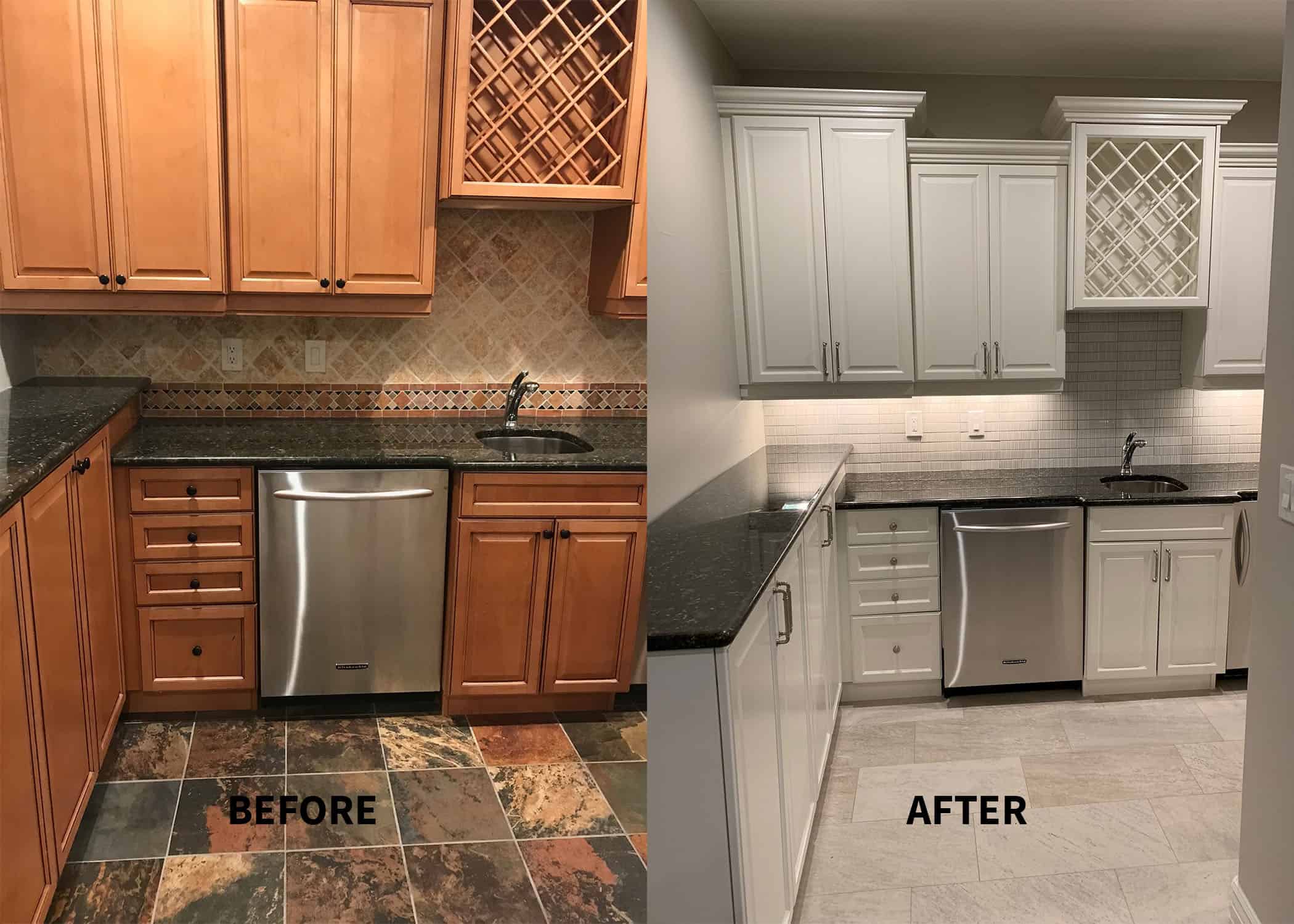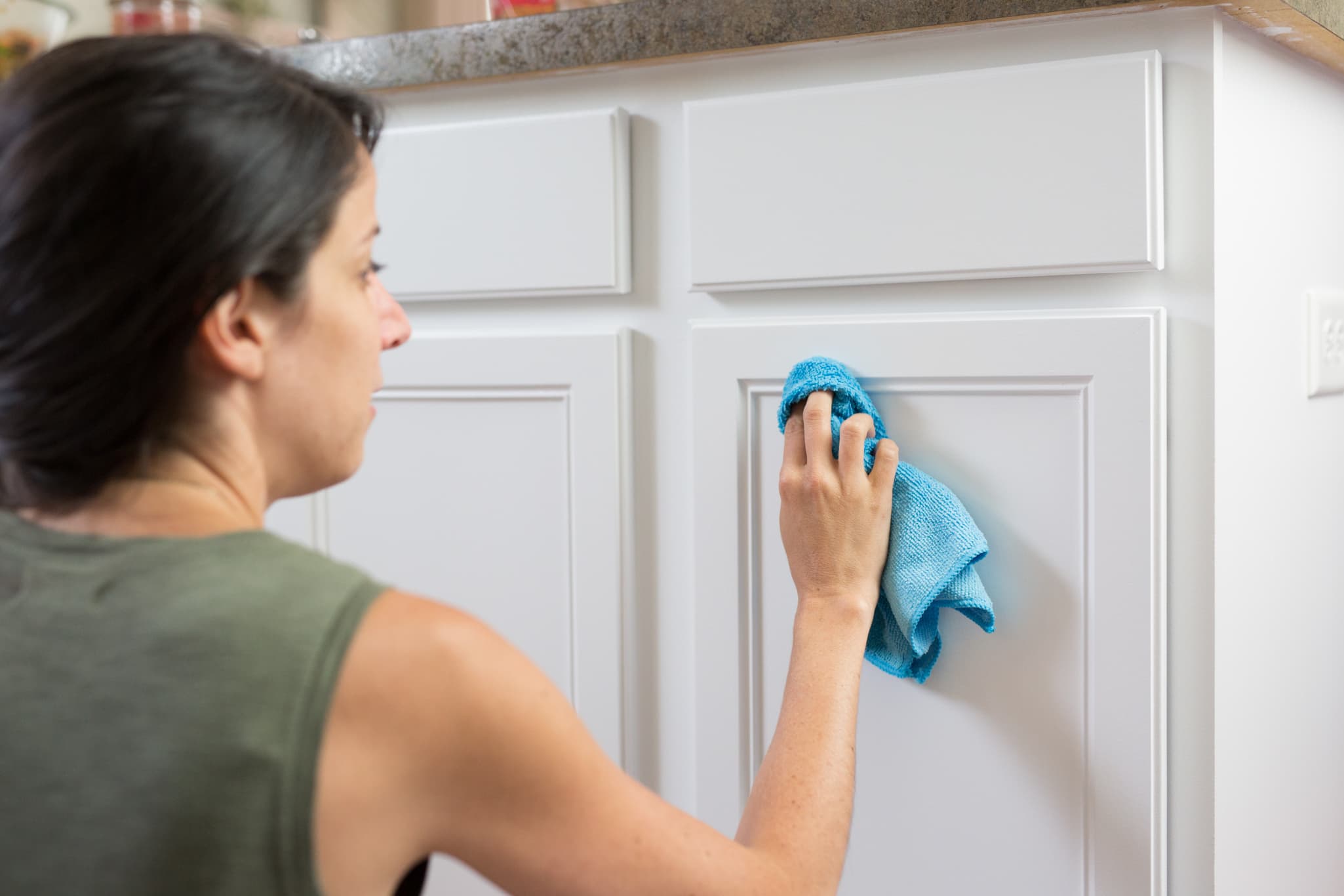Addressing Specific Cleaning Challenges: Kitchen Cabinet Cleaner Before Painting

Prepping your kitchen cabinets for a fresh coat of paint requires more than just a quick wipe-down. Thorough cleaning is crucial for paint adhesion and a long-lasting, beautiful finish. This means tackling those stubborn stains and paying close attention to the specific needs of your cabinet materials. Let’s dive into the details.
Grease Splatters Removal
Grease splatters are a common kitchen culprit, leaving behind a sticky, unsightly film. Effective removal requires a multi-step approach. First, gently loosen the grease with a solution of warm water and a mild dish soap. Apply the solution using a soft sponge or cloth, working in gentle, circular motions. Avoid harsh scrubbing, which could damage the cabinet surface. For stubborn splatters, let the solution sit for a few minutes to allow it to penetrate. Then, wipe clean with a clean, damp cloth, followed by a dry cloth to remove any remaining moisture. For particularly persistent grease, consider using a degreaser specifically designed for kitchen use, following the manufacturer’s instructions carefully.
Crayon Marks Removal
Kids and kitchen cabinets don’t always mix perfectly! Crayon marks, while seemingly innocuous, can be surprisingly tenacious. A paste of baking soda and water is often surprisingly effective. Apply a small amount of the paste to the crayon mark, gently rubbing it in with a soft cloth. Let it sit for a few minutes, then wipe clean with a damp cloth. For more stubborn marks, try a magic eraser (melamine foam), but test it in an inconspicuous area first, as it can be abrasive. Always remember to rinse the area thoroughly and dry it completely.
Sticky Residue Removal
Sticky residue from labels, tape, or spills can be frustrating to remove. A mixture of warm water and white vinegar (approximately equal parts) can be a helpful solution. Apply the mixture to the affected area and let it sit for several minutes to soften the residue. Then, gently scrape away the residue using a plastic scraper or a dull knife. Avoid using sharp objects, as they can scratch the cabinet surface. Finally, wipe the area clean with a damp cloth and dry thoroughly.
Cleaning Different Cabinet Materials, Kitchen cabinet cleaner before painting
The cleaning method you use will depend heavily on the material of your cabinets. Improper cleaning can damage the surface, so choosing the right approach is essential before you begin painting.
- Wood Cabinets: Use a mild soap and water solution. Avoid harsh chemicals or abrasive cleaners, which can damage the wood’s finish. Always test any cleaner in an inconspicuous area first. After cleaning, dry thoroughly to prevent water damage.
- Laminate Cabinets: Laminate is generally more durable than wood, allowing for the use of a slightly stronger cleaner. A solution of warm water and a mild dish soap is usually sufficient. For tougher stains, you can use a mild all-purpose cleaner. Avoid abrasive cleaners or scouring pads, which can scratch the surface.
- Melamine Cabinets: Melamine is very similar to laminate in terms of cleaning. A mild soap and water solution is typically adequate. For stubborn stains, you can try a slightly stronger cleaner, but always test it in an inconspicuous area first.
Cleaning Cabinet Hardware
Properly cleaning your cabinet hardware is vital to ensure a smooth paint application and prevent chipping. Different materials require different cleaning techniques. Imagine a visual guide showing a close-up of various hardware types (knobs, pulls, hinges) being cleaned using appropriate tools. For example, you’d see a soft cloth gently wiping down a brass knob, a toothbrush meticulously cleaning the crevices of an ornate pull, and a small brush removing dust from hinge pins.
- Metal Hardware: Use a soft cloth and a mild soap and water solution. For stubborn dirt, you can use a toothbrush to gently scrub the crevices. Rinse thoroughly and dry completely to prevent water spots.
- Ceramic Hardware: A soft cloth and mild soap and water solution are generally sufficient. Avoid abrasive cleaners, which can scratch the surface. Rinse and dry thoroughly.
- Glass Hardware: Use a soft cloth and a glass cleaner. Rinse thoroughly and dry completely to prevent streaks.
Post-Cleaning and Preparation for Painting

So, you’ve tackled the daunting task of cleaning your kitchen cabinets – congratulations! Now comes the equally important, and arguably more meticulous, phase: preparing them for paint. This stage sets the stage for a flawless, long-lasting finish. Skipping any of these steps can lead to a less-than-perfect paint job, so pay close attention to detail. Remember, patience is key here!
Cabinet Preparation Checklist
A thorough checklist ensures you haven’t missed any crucial steps. Remember, the smoother the surface, the better the paint will adhere and the more professional the final result will look. This isn’t just about aesthetics; a well-prepared surface prevents peeling and chipping down the line.
- Fill all holes and imperfections: Use wood filler to address any dents, scratches, or screw holes. Allow ample drying time before sanding.
- Sand the entire surface: Start with coarser grit sandpaper (around 120 grit) to remove any significant imperfections, then switch to finer grit (220 grit) for a smooth finish. Always sand in the direction of the wood grain.
- Clean again: After sanding, wipe down the cabinets thoroughly with a tack cloth to remove all dust particles. Dust is the enemy of a good paint job!
- Caulk gaps and seams: Use paintable caulk to fill any gaps or seams between cabinet doors and frames, ensuring a seamless look.
- Tape edges and hardware: Protect areas you don’t want painted using painter’s tape. Remove all cabinet hardware before starting.
Priming Kitchen Cabinets
Priming is absolutely crucial for a successful paint job, especially on kitchen cabinets which endure daily wear and tear. The right primer creates a strong bond between the cabinet surface and the topcoat, preventing peeling and ensuring a uniform finish. Choosing the wrong primer can be disastrous, leading to paint adhesion problems or even chemical reactions.
Choosing the right primer is paramount. Consider the cabinet material (wood, MDF, melamine) and the type of paint you’ll be using (oil-based, latex, etc.).
For example, if you have melamine cabinets (common in many modern kitchens), you’ll need a primer specifically designed for adhesion to this type of surface. A standard primer might simply peel right off. Similarly, if you’re using an oil-based paint, you might need an oil-based primer for optimal compatibility. Using a latex primer under oil-based paint could lead to adhesion problems.
Always test a small area before applying primer to the entire cabinet. This allows you to check for any reactions or inconsistencies.
When applying primer, use long, even strokes, avoiding drips and runs. Allow sufficient drying time between coats (usually 2-4 hours, depending on the primer and environmental conditions). Two thin coats are generally better than one thick coat. A high-quality primer will result in a smoother surface and better paint adhesion. I’ve found that using a brush for the detailed areas and a roller for the larger surfaces works best for me. Remember to clean your brushes and rollers immediately after use!
